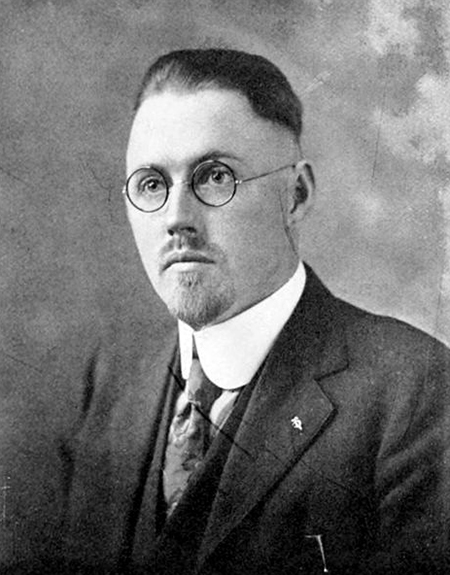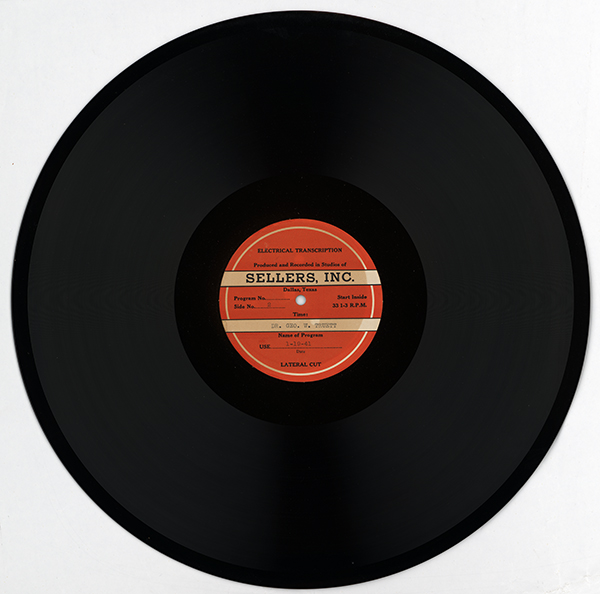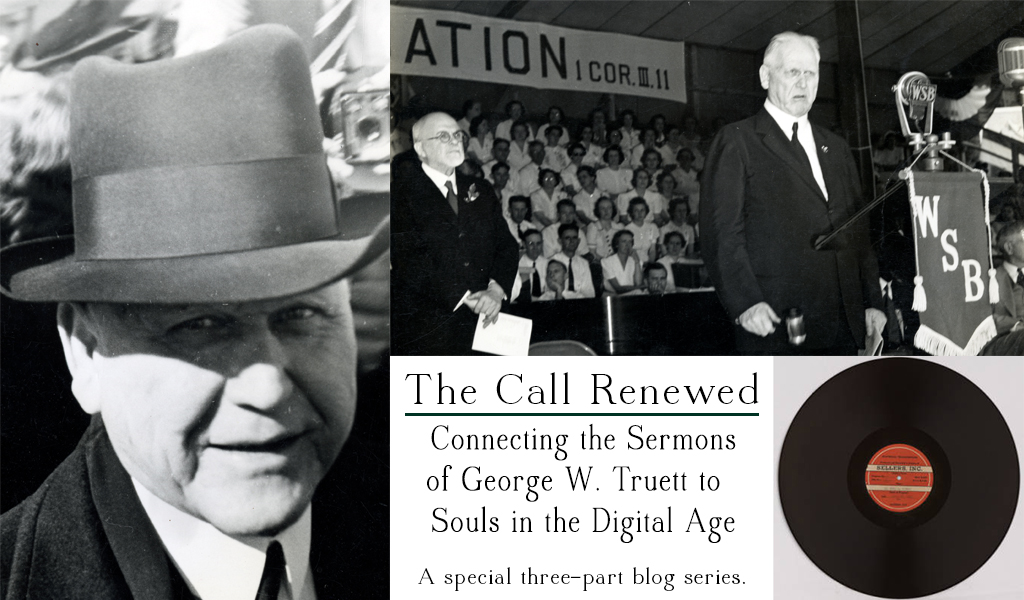This is the first installment in a special three-part blog series on the project to digitize and present online the final sermons of George W. Truett (1867-1944), noted pastor of First Baptist Church of Dallas and namesake of Baylor University’s George W. Truett Theological Seminary.
One of the most interesting examples of God’s ability to use anyone – or anything – to serve Him is recounted in the twenty-second chapter of the book of Numbers. It is the story of Balaam’s donkey, and if you haven’t read it, do so now, for it demonstrates God’s ability to speak through even the dumbest of beasts when it will be the most effective means of getting the message across.
Balaam’s donkey is a particularly apt comparison to the strange story of how a “border blaster” radio station founded by a convicted medical charlatan would be used to broadcast the final sermons of a powerful Baptist minister to the citizens of three North American countries.
The Strange Case of John Romulus Brinkley
Our story begins with a man named John Brinkley. His was a fascinating life filled with accusations of bigamy, failed attempts to acquire a legitimate medical license, multiple (unsuccessful) campaigns to gain public office, a rise to wealth, a stint as a pioneer in radio broadcasting, and an ignominious, penniless death.

Brinkley’s life is spelled out in agonizing detail in his well-researched Wikipedia entry, so we won’t get too in-depth with this post. Suffice to say, Brinkley was a man with a showman’s instincts and a scalawag’s morals, willing to lie, cheat and defraud to achieve his goals. But like many larger-than-life figures, he also showed bursts of genuine goodness, such as the time he used profits from his successful radio show to purchase a municipal sewer system and other much-needed amenities for the small town of Milford, Kansas.
After telling a male patient he would have no problems with infertility if he had a pair of “goat glands” in him, Brinkley hit on the idea of transplanting the reproductive glands of goats into patients – male and female – who were suffering from various ailments, primarily sexual dysfunction or infertility but also spinal tumors, dementia and even flatulence. Brinkley touted his “cure” with the claim that it would turn previously infertile men into the “ram that am with every lamb,” despite the fact that most patients merely absorbed the glands into their bodies with little or no evidence of an improvement in their underlying condition.
Not surprisingly, his actions drew the attention of the American Medical Association and the crusading physician who would eventually be his downfall. Morris Fishbein would publish a two-part series entitled “ Modern Medical Charlatans,” wherein he exposed Brinkley as a dangerous fraud. Brinkley sued Fishbein for libel, and Fishbein won the case after a jury found that Brinkley “should be considered a charlatan and a quack in the ordinary, well-understood meaning of those words.”
In addition to losing the libel case, Brinkley also faced investigations from the IRS and the U.S. Post Office late in his life. These challenges, combined with a loss of income and deteriorating health, culminated in his death in 1942, a penniless shadow of the man who once ran for governor of Kansas with the promise of providing lower taxes, old-age pensions and a lake in every county. (He managed to gain nearly 30% of the popular vote.)
A Radio Pioneer, But Old Habits Die Hard
As his goat gland “cure” began to turn significant profits in the early 1920s, Brinkley became interested in the power of the radio as a marketing medium and started a station in Kansas under the call letters KFKB. He used this new-found reach to promote his treatments, which he espoused for hours. He interspersing his sales pitches with a diverse range of programming that included, “military bands, French lessons, astrological forecasts, storytelling and exotica such as native Hawaiian songs.”
His success in radio boosted profits through the roof, but his roots as an old-school snake oil seller ran deep. Brinkley began a segment he called the “Medical Question Box,” where listeners wrote in with their various medical concerns which he addressed over the air. Inevitably, the perfect cure for whatever ailed listeners was a patent medicine available only at a pharmacy that participated in his “Brinkley Pharmaceutical Association.” It was estimated that Brinkley made more than $10 million per year (in current value) on the sale of these “medicines.”
Before the Federal Radio Commission shut it down, Brinkley’s station made him a multimillionaire. However, he saw a new opportunity to expand his empire by constructing a 50,000-watt station in Villa Acuña, Mexico, just across the U.S-Mexico border from Del Rio, Texas. Eventually, the Mexican government allowed him to up the wattage of XER to 150,000, making his station audible to citizens of Mexico, the United States and – on nights when the conditions were perfect – as far away as Canada. He resumed his patent medicine-selling ways, taking on new advertisers hocking everything from “genuine simulated” diamonds to autographed pictures of Jesus. During this period Brinkley also purchased Mexican radio station XED; he changed its name to XEAW before selling the station in 1939. XEAW’s new owner would form the link between Brinkley, the power of radio and the Word of God.
A New Owner for XEAW
Carr Collins was another Texas-sized personality when he enters our narrative in the late 1930s. Like Brinkley, Collins had made a sizable fortune selling a “cure” for a common ailment. His approach was to use the radio to sell “Crazy Crystals,” dehydrated minerals from the springs found at Mineral Wells, Texas. When they were re-hydrated and consumed, the crystals were purported to act as a laxative. Collins had also profited from his establishing the Fidelity Union Life Insurance Company, and in his last decades he would use his fortune to support numerous philanthropic causes.
In addition to his prowess as a salesman, Collins was a devout Baptist. He became involved with the leadership of the First Baptist Church of Dallas, where he came into contact with its influential and long-serving pastor, George W. Truett. At some point in the late 1930s or early 1940s, Collins’ station made the decision to broadcast a new kind of program.
Reaching the People of “Radio Land”
By 1941, Truett had entered into the final years of his life. But despite his advanced age and failing health, he continued to deliver weekly sermons and even preside over special week-long programs focusing on prayer, revival and revitalizing the faith of the people of Dallas. At some point in the early 1940s, he entered into an agreement with Collins to broadcast recorded versions of his weekly sermons over the air on XEAW. The sermons were recorded live in the pulpit at First Baptist Dallas on 16” radio transcription discs. These discs were then shipped to the port of entry at Hidalgo, Texas for shipment into Mexico via the city of Reynosa. They would eventually air on XEAW, typically a week later than the dates of their original delivery in Truett’s Dallas pulpit.

Notes written on the existing discs’ labels indicate that an XEAW announcer would read the following script at the end of each broadcast:
“You have been listening to a message by Dr. George W. Truett, Pastor of the First Baptist Church of Dallas. These messages will be presented over XEAW every Sunday evening at 9:30. Tell your friends and neighbors about these.”
Thanks to the joint efforts of two major Dallas citizens – the preacher and the businessman – the people of Mexico, Texas and the entire Southwest could hear the words of one of the biggest names in Southern Baptist history delivered directly to their homes.
The Discs Find New Life in Digital
At least 68 of these broadcast discs were created by the studios of Sellers, Inc. of Dallas. These discs made their way into The Texas Collection at some point after Truett’s death, where they have been preserved along with their original album sleeves. In the fall of 2012, the discs were delivered to the Digital Projects Group to take advantage of our analogue disc migration capabilities and the skills of audio/visual engineer Stephen Bolech.
After organizing the discs into chronological order, Stephen migrates them one side at a time. Because of the original setup used to record them in the 1940s – wherein an audio engineer used two turntables to record the entire sermon over the course of three album sides – Stephen will import three sides of audio and create preservation digital files for each side. Then, he stitches the audio together and enhances it to create the high-quality access versions you will find presented in our Digital Collections.
This approach is a slight departure from our standard operating procedure in that we are presenting “enhanced” audio as opposed to the un-tweaked, “raw” version you would hear in collections like the Black Gospel Music Restoration Project. We chose to present the sermons in a listener-friendly, cleaner format both to aid in comprehension and because of the simpler nature of the audio’s original format – a single voice speaking alone, as opposed to numerous musicians and vocalists layered together.
In addition to the audio files, I am creating transcriptions of the sermons to add to the digital item. This will allow them to be keyword searchable and makes for a helpful aid for researchers interested in diving into the heart of Truett’s message.
All told, this means that each digital item includes a scanned image of all three sides of the discs, the enhanced audio of the sermon and a fully searchable transcript. In short, it is as complete a record as you will find online of any early 20th century preacher’s live, from-the-pulpit sermons.
What’s Next for the Collection?
We are working to complete phase one of the project by the end of the summer. This will mean putting all of Truett’s sermons from 1941 online by the end of August, with the sermons from 1942 and 1943 to follow shortly thereafter. The process for creating these records is a painstaking one, and we are committed to providing the highest quality resources for our users; hence, the staggered release. The first 17 sermons from the project are available now from the Truett Sermons Collection.
(Note: There are an additional 26 albums’ worth of Truett sermons available in this collection as well. These sermons were released by Word Records in the mid-1960s. We plan to create transcripts for these sermons in the future.)
Please take a few moments at your earliest convenience and head over to the collection to take a listen for yourselves. The sound of Truett’s voice, the focus of his message and the immediacy of its content cannot fail to strike a chord, and we encourage your feedback as you discover the items in this collection.
Next week’s blog post will focus on the content of the sermons themselves, from the types of subjects tackled to a brief examination of Truett’s inimitable style. Then, we’ll complete our Truett trifecta with a big announcement about another way you can engage with the collection that will combine 20th century preaching with 21st century technology. Stay tuned!
Sources Consulted:
Gene Fowler and Bill Crawford, “BORDER RADIO,” Handbook of Texas Online (http://www.tshaonline.org/handbook/online/articles/ebb01), accessed July 19, 2013. Published by the Texas State Historical Association.
“John R. Brinkley.” Wikipedia. Retrieved on July 22, 2013 from http://en.wikipedia.org/wiki/John_R._Brinkley
George N. Green, “COLLINS, CARR P.,” Handbook of Texas Online (http://www.tshaonline.org/handbook/online/articles/fco90), accessed July 19, 2013. Published by the Texas State Historical Association.
Joan Jenkins Perez, “TRUETT, GEORGE WASHINGTON,” Handbook of Texas Online (http://www.tshaonline.org/handbook/online/articles/ftr16), accessed July 22, 2013. Published by the Texas State Historical Association.
